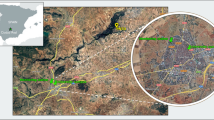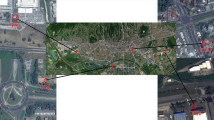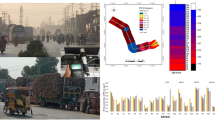Abstract
Understanding and controlling air pollution in highly populated areas is very important, although interpreting the levels of gaseous pollutants and airborne particulate matter is complicated by dominant natural and anthropogenic emissions, micro-meteorological processes, and chemical reactions which take place directly in the atmosphere. For this reason, it is very difficult to relate the characteristics of air pollution to one or more specific emission sources. The aim of this paper is to detect associations among elements and organic compounds emitted from specific sources by means of chemical analyses, statistical processing of data, seasonal evolution study, and geochemical considerations to trace their origin. A detailed characterization of air quality during the period September 2000–September 2001 was carried out in three locations of the Venice region: A heavy traffic urban site, a public park, and the island centre of the city of Venice. Twenty-eight inorganic elements, four polycyclic aromatic hydrocarbons, CO and benzene were quantified and processed by a statistical procedure based on factor analysis considering variations on a seasonal basis. Results show the presence of associations between elements and compounds with the same behaviour in all sampling points. This indicates that several pollutants originate from a common source, and are then “diluted” throughout the study area, maintaining the imprint of their origin. Pt, polycyclic aromatic hydrocarbons, CO and benzene originating from the exhaust gas of vehicles are all linked in the traffic factor, whereas Cd is associated with Se, having a common source in industrial processes.






Similar content being viewed by others
Explore related subjects
Discover the latest articles and news from researchers in related subjects, suggested using machine learning.References
Adachi, K., & Tainosho, Y. (2004). Characterization of heavy metal particles embedded in tire dust. Environment International, 30, 1009–1017.
Argese, E., Rigo, C., Bedini, S., Simion, M., & Rampazzo, G. (2005). Characterization of a dismissed site contaminated by heavy ashes of solid wastes. Caratterizzazione di un sito dimesso contaminato da ceneri pesanti di rifiuti solidi urbani. Bologna: Ecomondo Maggioli Editore (in Italian).
Bertolaccini, A., & Gucci, P. M. B. (1985). Atmospheric pollution in the Venice area. I. Sulphur dioxide, suspended particles and sulphates. Science of the Total Environment, 43, 243–253.
Bertolaccini, A., & Gucci, P. M. B. (1986). Atmospheric pollution in the Venice area. II. Iron, manganese, lead, vanadium and cadmium in suspended particulate. Science of the Total Environment, 57, 7–17.
Camuffo, D. (1981). Fluctuations in wind direction at Venice related to the origin of the air masses. Atmospheric Environment, 15(9), 1543–1551.
Camuffo, D. (1982). The sea breeze at Venice, as related to daily global solar radiation. Boundary–Layer Meteorology, 23(2), 175–184.
Casetta, B., Giaretta, A., & Rampazzo, G. (1986). Determination of phosphorus in siliceous rocks by atomic absorption spectrophotometry with a graphite furnace. Atomic Spectroscopy, 7(5), 155–157.
Chan, S. H., & Hoang, D. L. (1999). Heat transfer and chemical reactions in exhaust system of a cold-start engine. International Journal of Heat and Mass Transfer, 42, 4165–4183.
D’Alessandro, A., Lucarelli, F., Mandò, P. A., Marcazzan, G., Nava, S., Prati, P., et al. (2003). Hourly elemental composition and sources identification of fine and coarse PM10 particulate matter in four Italian towns. Journal of Aerosol Science, 34, 243–259.
Davis, J. C. (1986). Statistics and data analysis in geology. New York: Wiley.
De Lazzari, A., Rampazzo, G., & Pavoni, B. (2004). Geochemistry of sediments in the Northern and Central Adriatic Sea. Estuarine, Coastal and Shelf Science, 59, 429–440.
Englert, N. (2004). Fine particles and human health—a review of epidemiological studies. Toxicology Letters, 149, 235–242.
Farrauto, R. J., & Heck, R. M. (1999). Catalytic converters: State of the art and perspectives. Catalysis Today, 51, 351–360.
Farrauto, R. J., & Voss, K. E. (1996). Monolithic diesel oxidation catalysts. Applied Catalysis, 10B, 29–51.
Fukuzaki, N., Yanaka, T., & Urushiyama, Y. (1986). Effects of studded tires on roadside airborne dust pollution in Niigata, Japan. Atmospheric Environment, 20, 377–386.
Gambaro, A., Manodori, L., Moret, I., Capodoglio, G., & Cescon, P. (2004). Determination of polychlorobiphenyls and polycyclic aromatic hydrocarbons in the atmospheric aerosol of the Venice Lagoon. Analytical and Bioanalytical Chemistry, 378, 1806–1814.
Gentzis, T., & Goodarzi, F. (2000). Effect of geological processes on coal quality and utilization potential: Review with examples from western Canada. Journal of Hazardous Materials, 74, 109–124.
Harrison, R. M., Tilling, R., Callén Romero, M. S., Harrad, S., & Jarvis, K. (2003). A study of trace metals and polycyclic aromatic hydrocarbons in the roadside environment. Atmospheric Environment, 37, 2391–2402.
Hueglin, C., Gehrig, R., Baltensperger, U., Gysel, M., Monn, C., & Vonmont, H. (2005). Chemical characterisation of PM2.5, PM10 and coarse particles at urban, near-city and rural sites in Switzerland. Atmospheric Environment, 39, 637–651.
Kašpar, J., Fornasiero, P., & Hickey, N. (2003). Automotive catalytic converters: Current status and some perspectives. Catalysis Today, 77, 419–449.
Kašpar, J., Graziani, M., & Fornasiero, P. (2000). Ceria-containing three way catalysts. In K. A. Gschneidner Jr. & L. Eyring (Eds.), Handbook on the physics and chemistry of rare earths: The role of rare earths in catalysis (pp. 159–267). Amsterdam: Elsevier.
Korhonen, P., & Siljamäki, A. (1998). Ordinal principal component analysis. Theory and application. Computational Statistics and Data Analysis, 26, 411–424.
Kupiainen, K. J., & Tervahattu, H. (2005). Size and composition of airborne particles from pavement wear, tires, and traction sanding. Environmental Science & Technology, 39(3), 699–706.
Landais, P. (1996). Organic geochemistry of sedimentary uranium ore deposits. Ore Geology Reviews, 11, 33–51.
Lebart, L., Morineau, A., & Warwick, K. M. (1984). Multivariate descriptive statistical analysis. New-York: Wiley.
Lim, M. C. H., Ayoko, G. A., Morawska, L., Ristovski, Z. D., Jayaratne, E. R., & Kokot, S. (2006). A comparative study of the elemental composition of the exhaust emissions of cars powered by liquefied petroleum gas and unleaded petrol. Atmospheric Environment, 40, 3111–3122.
Mantovan, I., Rado, N., Rampazzo, G., & Visin, F. (2003). Correlation among some inorganic and organic elements in the particulate matter (PM10) in the area of Venezia–Mestre. Annali di Chimica, 93, 421–428.
Marcazzan, G. M., Valli, G., & Vecchi, R. (2002). Factors influencing mass concentration and chemical composition of fine aerosols during a PM high pollution episode. Science of the Total Environment, 298, 65–79.
Meima, J. A., & Comans, R. N. J. (1999). The leaching of trace elements from municipal solid waste incinerator bottom ash at different stage of weathering. Applied Geochemistry, 14, 159–171.
Meima, J. A., van der Weijden, R., Taylor Eighmy, T., & Comans, R. N. J. (2002). Carbonation processes in municipal solid waste incinerator bottom ash and their effect on the leaching of copper and molybdenum. Applied Geochemistry, 17, 1503–1513.
Neyestanaki, A. K., Klingstedt, F., Salmi, T., & Murzin, D. Y. (2004). Deactivation of postcombustion catalysts, a review. Fuel, 83, 395–408.
Nielsen, T. (1996). Traffic contribution of polycyclic aromatic hydrocarbons in the center of a large city. Atmospheric Environment, 30(20), 3481–3490.
Papp, Z., Dezső, Z., & Daróczy, S. (2002). Significant radioactive contamination of soil around a coal-fired thermal power plant. Journal of Environmental Radioactivity, 59, 191–205.
Piantone, P., Bodénan, F., & Chatelet-Snidaro, L. (2004). Mineralogical study of secondary mineral phases from weathered MSWI bottom ash: Implications for the modelling and trapping of heavy metals. Applied Geochemistry, 19, 1891–1904.
Ravindra, K., Bencs, L., & Van Grieken, R. (2004). Platinum group elements in the environment and their health risk. Science of the Total Environment, 318(1–3), 1–43.
Scalet, B. M., Slade, S., Kasper, A., Van Marcke Lummen, G., Gitzhofer, K., & Van Limpt, H. (2006). Selenium emission from glass melting furnaces: Formation, sampling and analysis. Glass Technology, 47(2A), 29–38.
Schauer, J. J., Kleeman, M. J., Cass, G. R., & Simoneit, B. T. (2002). Measurement of emissions from air pollution sources. 5. C1-C32 Organic compounds from gasoline-powered motor vehicles. Environmental Science & Technology, 36, 1169–1180.
Smith, D. J. T., & Harrison, R. M. (1996). Concentrations, trends and vehicle source profile of polynuclear aromatic hydrocarbons in the U.K. atmosphere. Atmospheric Environment, 30, 2513–2525.
Sternbeck, J., Sjodin, A., & Andreason, K. (2002). Metal emissions from road traffic and the influence of resuspension—Results from two tunnel studies. Atmospheric Environment, 36, 4735–4744.
Swan, A. R. H., & Sandilands, M. (1995). Introduction to geological data analysis. Oxford: Blackwell Science.
Vallius, M., Janssen, N. A. H., Heinrich, J., Hoek, G., Ruuskanen, J., Cyrys, J., et al. (2005). Sources and elemental composition of ambient PM2.5 in three European cities. Science of the Total Environment, 337, 147–162.
Wongphatarakul, V., Friedlander, S. K., & Pinto, J. P. (1998). A comparative study of PM2.5 ambient aerosol chemical databases. Environmental Science and Technology, 32(24), 3926–3934.
Yang, H., Yu, J. Z., Ho, S. S. H., Xu, J. H., Wu, W. S., Wan, C. H., et al. (2005). The chemical composition of inorganic and carbonaceous materials in PM2.5 in Nanjing, China. Atmospheric Environment, 39, 3735–3749.
Zereini, F., & Alt, F. (2000). Anthropogenic platinum-group element emissions. Their impact on man and environment. Berlin: Springer.
Zięba-Palus, J., & Kościelniak, P. (2000). An analysis of the similarity of motor oils on the basis of their elemental composition. Forensic Science International, 112, 81–90.
Acknowledgment
This work was carried out with the aid and collaboration of Ente della Zona Industriale di Porto Marghera—Centro Elaborazione Dati Rete Antinquinamento. Ms. Gabriel Walton revised the English text. Some data of this paper are obtained from the dissertation of Dr. Ilaria Mantovan.
Author information
Authors and Affiliations
Corresponding author
Rights and permissions
About this article
Cite this article
Rampazzo, G., Masiol, M., Visin, F. et al. Gaseous and PM10-Bound Pollutants Monitored in Three Sites with Differing Environmental Conditions in the Venice Area (Italy). Water Air Soil Pollut 195, 161–176 (2008). https://doi.org/10.1007/s11270-008-9735-7
Received:
Accepted:
Published:
Issue Date:
DOI: https://doi.org/10.1007/s11270-008-9735-7




